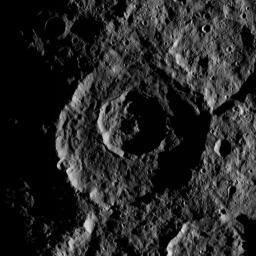
|
Dawn XMO2 Image 31
- Click the image above for a larger view
- Full-Res JPEG (1024 x 1024) (167.2 kB)
- Full-Res TIFF (1024 x 1024) (829.7 kB)
Caption:
The low angle of illumination brings this pair of nested craters near Ceres' south pole into sharp relief. The larger exterior crater is 53 miles (85 kilometers) in diameter and more than 1.6 miles (2.5 kilometers) deep.
The inner crater displays a central peak, which rises above the darker shadow regions surrounding it. Similar central structures are found in mid-sized craters across the solar system. The central structure in the larger, exterior crater was likely obliterated by the impact of the inner crater. A complex, lobe-shape, flow-like feature, possibly a landslide triggered by an impact on the crater's rim, is visible on the southwest wall of the larger crater. Such flows are common within Ceres' craters.
This picture was obtained by the Dawn spacecraft on October 24, 2016, from an altitude of about 930 miles (1500 kilometers).
The image is located at 73 degrees south latitude, 175 degrees east longitude.
Background Info:
Dawn's mission is managed by JPL for NASA's Science Mission Directorate in Washington. Dawn is a project of the directorate's Discovery Program, managed by NASA's Marshall Space Flight Center in Huntsville, Alabama. UCLA is responsible for overall Dawn mission science. Orbital ATK, Inc., in Dulles, Virginia, designed and built the spacecraft. The German Aerospace Center, the Max Planck Institute for Solar System Research, the Italian Space Agency and the Italian National Astrophysical Institute are international partners on the mission team. For a complete list of mission participants, see http://dawn.jpl.nasa.gov/mission .
For more information about the Dawn mission, visit http://dawn.jpl.nasa.gov .
Cataloging Keywords:
| Name | Value | Additional Values |
|---|---|---|
| Target | 1 Ceres | |
| System | Main Belt | |
| Target Type | Dwarf Planet | Asteroid |
| Mission | Dawn | |
| Instrument Host | Dawn | |
| Host Type | Orbiter | |
| Instrument | Framing Camera (FC) | |
| Detector | ||
| Extra Keywords | Crater, Grayscale, Impact, Shadow | |
| Acquisition Date | ||
| Release Date | 2017-02-01 | |
| Date in Caption | 2016-10-24 | |
| Image Credit | NASA/JPL-Caltech/UCLA/MPS/DLR/IDA | |
| Source | photojournal.jpl.nasa.gov/catalog/PIA21396 | |
| Identifier | PIA21396 | |
